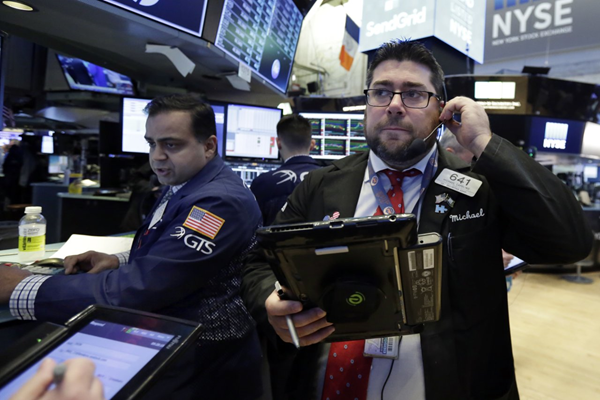THE
WALL STREET JOURNAL.
Markets
Saying Bye to Buybacks
Companies in the S&P
500 are on pace to spend the least on buybacks since 2012
|

A slowing pace of buybacks hasn’t hindered stock
prices much, with major indexes climbing to scores of fresh
records this year. PHOTO: RICHARD DREW/ASSOCIATED PRESS |
By
Ben Eisen and
Chris Dieterich
Updated Nov. 23, 2017 2:47 p.m. ET
Large companies are
repurchasing their shares at the slowest pace in five years, as record
U.S. stock indexes and an expanding economy propel more money out of
flush corporate coffers into capital spending and mergers.
Companies in the S&P 500 are on pace to spend $500 billion this
year on share buybacks, or about $125 billion a quarter, according to data from
INTL FCStone. That is the least since 2012 and down from a quarterly average of
$142 billion between 2014 and 2016.
Ebbing Trend
The pace of buybacks
among S&P 500 companies is expected to have slowed this year
Buybacks have been popular in recent years, in part because tepid
economic growth limited perceived investment opportunities as well as expected
returns on new plant and expanded operations. Adding to their appeal,
repurchases can make shares more attractive to investors by lowering the share
count and accordingly increasing earnings per share. The postcrisis surge in
buybacks has been frequently cited by stock-market bears as a sign that the
market’s eight-year-long advance has been driven more by financial engineering
than by long-term growth.
But this year, companies have pulled back from buybacks,
reflecting in part an uptick in the global economy, rising consumer and investor
sentiment and expectations that a rally that has taken the Dow industrials up
19% this year cannot continue indefinitely.
“Persistently high business sentiment since the election of [U.S.
President Donald] Trump has convinced corporate chieftains that cash can be put
to better use than retiring stocks,” said Vincent Deluard, INTL FCStone’s head
of global macro strategy.
Capital expenditures by U.S. companies have been muted for most
of the postcrisis recovery. But a Federal Reserve Bank of Philadelphia index
that forecasts such spending for manufacturing companies over the next six
months
climbed to its highest level in more than
30 years over the summer.
Opening the Wallet
A measure of expected
CapEx over the next six months was recently at a three-decade high
Buyback activity among top-rated nonfinancial debt issuers, many
of which have regularly borrowed money to finance share repurchases, declined
for the third straight quarter in the July-to-September period, according to
Bank of America Merrill Lynch. Meanwhile, mergers and acquisitions among that
group of companies had their biggest quarter of the year, analysts at the bank
said.
A slowing pace of buybacks hasn’t hindered stock prices much,
with major indexes climbing to
scores of fresh records this year.
Corporations are still major buyers of their own shares and are
expected to remain so next year. Analysts at Goldman Sachs forecast a 3% uptick
in buybacks to $510 billion in 2018.
Where to Spend?
Shareholder returns
as a portion of sales this economic cycle have been high, while capital
expenditures have been low.
One wild card for future buybacks is
the tax-overhaul legislation being
negotiated on Capitol Hill. Multinational companies have parked over $1 trillion
in profit earned overseas to avoid paying the 35% U.S. corporate tax rate. The
House tax bill
approved this month would impose a reduced
one-time tax rate on such offshore cash, an incentive to bring money back home.
It is not clear to what degree companies would use repatriated
cash to fund capital expenditures and acquisitions, buy back shares or raise
dividends. The decline in buybacks this year, and an uptick in spending on
investment and dividends, is prompting some analysts to predict that a tax-law
change in this cycle could play out differently than it did in 2004, when much
of the money that companies brought back from overseas was funneled directly
into share repurchases.
Factors including high stock price, historically high share
valuations and uncertainty over the future shape of the tax code mean that
“companies may be less likely to favor buybacks over other uses of cash in
2018,” analysts at Goldman Sachs Group Inc. said in a report this week.
But other changes in the economy, markets and the regulatory
environment could increase repurchase activity next year. The largest U.S.
financial firms are becoming free to return more cash to shareholders. After the
financial crisis, regulations required the Federal Reserve to sign off on banks’
capital plans. The improving health of financial firms should clear the way for
more bank buybacks in the years ahead, analysts say.
There are some signs that investors are no longer as drawn to
companies that buy back shares in large quantities. The
PowerShares BuyBack Achievers Portfolio , a
$1.3 billion exchange-traded fund tracking companies that have decreased their
share counts over the past year, has had more than $200 million in outflows
since the end of last year, according to data provider XTF.
To be sure, companies are still returning cash to investors in
other ways. Dividend payments by S&P 500 companies are poised to set a sixth
consecutive record in 2017, according to S&P Dow Jones Indices.
Write to
Ben Eisen at
ben.eisen@wsj.com and Chris Dieterich at
chris.dieterich@wsj.com
Appeared in the November 24,
2017, print edition as 'Firms Cut Buybacks As Stocks Become Expensive.'